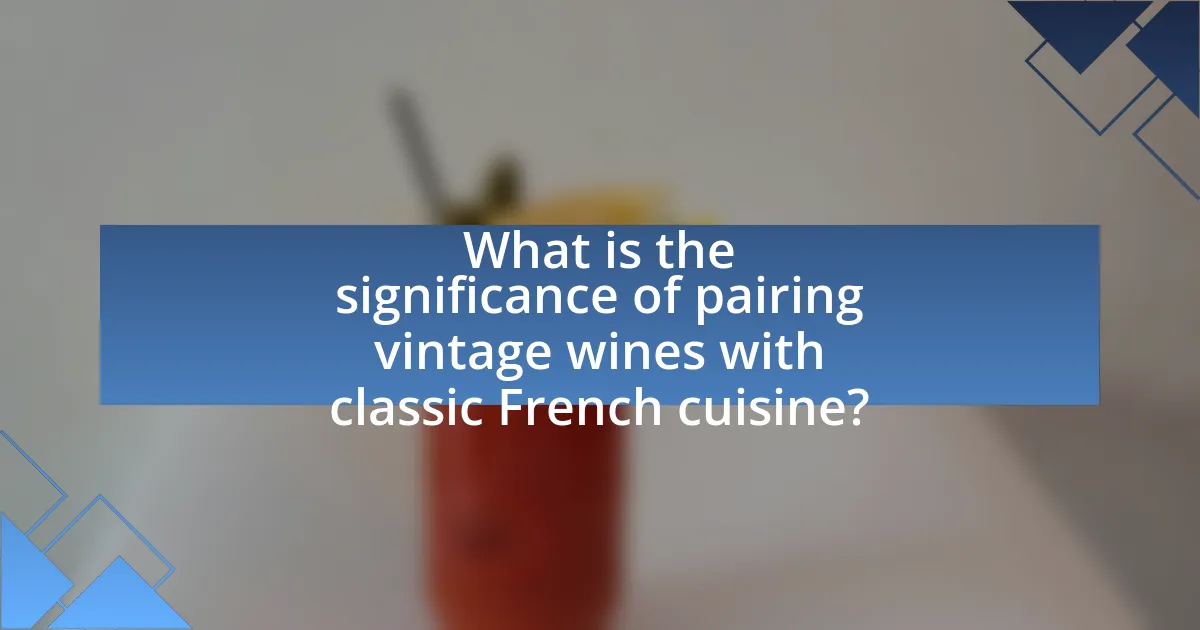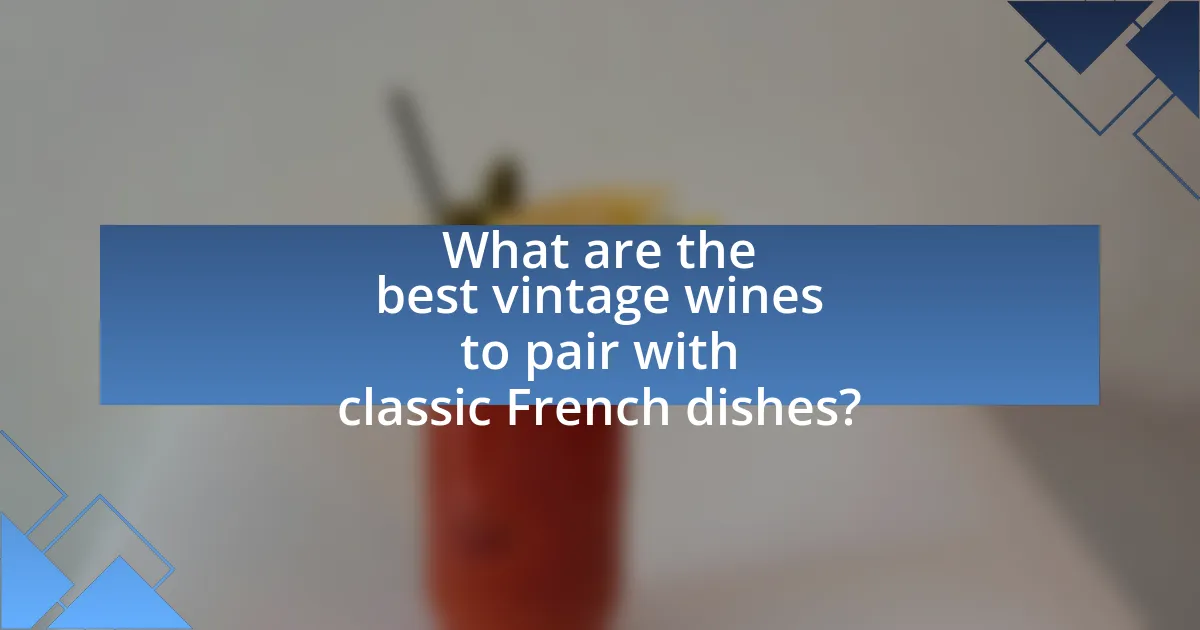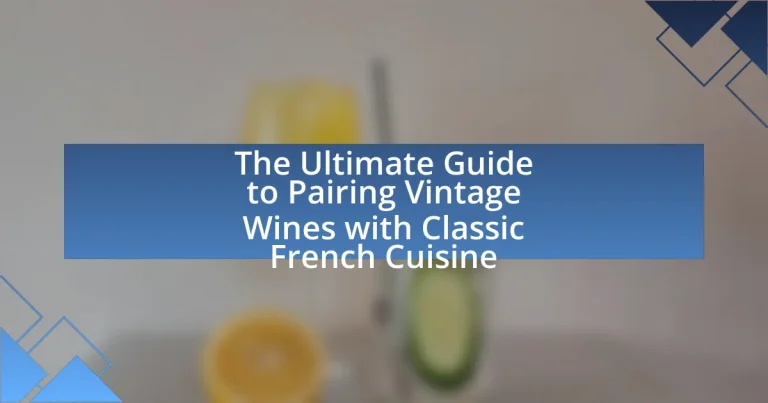The article focuses on the significance of pairing vintage wines with classic French cuisine, emphasizing how complementary flavors and aromas enhance the dining experience. It explores the historical influence of French culinary traditions on wine selection, detailing specific traditional dishes and their ideal wine pairings, such as Coq au Vin with Burgundy and Beef Bourguignon with robust red wines. Additionally, the article discusses the evolution of wine pairing practices, the characteristics of vintage wines, and key principles for successful pairings, including the roles of acidity and tannins. It also provides practical tips for beginners on selecting and serving vintage wines, as well as resources for further learning about wine and food pairing.

What is the significance of pairing vintage wines with classic French cuisine?
Pairing vintage wines with classic French cuisine is significant because it enhances the dining experience through complementary flavors and aromas. Vintage wines, often aged to develop complex characteristics, can elevate traditional French dishes by matching their richness and depth. For instance, a well-aged Bordeaux can harmonize with the savory notes of coq au vin, while a vintage Champagne can cut through the richness of a buttery sauce, creating a balanced palate. This practice is rooted in the French culinary tradition, where specific wines are historically associated with regional dishes, ensuring that the pairing not only respects the heritage of the cuisine but also maximizes the sensory enjoyment of both the food and the wine.
How does the history of French cuisine influence wine pairing?
The history of French cuisine significantly influences wine pairing by establishing regional traditions that dictate which wines complement specific dishes. French culinary practices, dating back to the Middle Ages, emphasized the importance of local ingredients and flavors, leading to the development of distinct regional cuisines, such as Provençal, Burgundy, and Alsatian. Each region has its own traditional dishes that have evolved alongside local wine production, creating a natural synergy between food and wine. For example, the classic pairing of Coq au Vin with Burgundy wine stems from the historical use of local wines in cooking, enhancing the dish’s flavors. This deep-rooted connection between cuisine and wine in France is further supported by the concept of terroir, which highlights how the environment influences both food and wine, reinforcing the idea that certain wines are inherently suited to specific dishes.
What traditional French dishes are most commonly paired with vintage wines?
Traditional French dishes commonly paired with vintage wines include Coq au Vin, Beef Bourguignon, and Duck Confit. Coq au Vin, a chicken dish braised with wine, mushrooms, and lardons, complements red Burgundy wines, enhancing the dish’s rich flavors. Beef Bourguignon, a hearty beef stew cooked in red wine, is ideally matched with robust wines like Pinot Noir, which accentuates the dish’s depth. Duck Confit, featuring slow-cooked duck leg, pairs well with aged Bordeaux, as the wine’s tannins balance the dish’s richness. These pairings are rooted in French culinary tradition, where the harmony between food and wine is essential for an authentic dining experience.
How have wine pairing practices evolved in French culinary culture?
Wine pairing practices in French culinary culture have evolved from rigid regional pairings to a more flexible and innovative approach. Historically, French cuisine emphasized matching specific wines with traditional dishes based on regional availability and established guidelines, such as pairing Bordeaux with red meats and Burgundy with poultry. However, contemporary practices now embrace a broader understanding of flavor profiles, allowing chefs and sommeliers to experiment with unconventional pairings that enhance the dining experience. This shift is supported by the rise of culinary creativity and globalization, which have introduced diverse influences and encouraged a more personalized approach to wine selection, reflecting individual tastes rather than strict adherence to tradition.
Why is vintage wine particularly suited for French cuisine?
Vintage wine is particularly suited for French cuisine due to its complex flavors and aromas that complement the intricate profiles of traditional French dishes. The aging process of vintage wines enhances their depth, allowing them to pair harmoniously with the rich, diverse ingredients commonly found in French cooking, such as butter, cream, and herbs. For instance, a vintage Bordeaux can elevate a classic coq au vin by matching its robust flavors, while an aged Burgundy can enhance the subtlety of a dish like duck confit. This synergy between vintage wines and French cuisine is rooted in the historical significance of wine in French culture, where wine has been an integral part of meals for centuries, often crafted to enhance the dining experience.
What characteristics define vintage wines?
Vintage wines are defined by their age, quality, and the specific year of harvest, which significantly influences their flavor profile and complexity. Typically, a wine is considered vintage if it is made from grapes harvested in a single year, and this year is prominently indicated on the label. The characteristics of vintage wines often include enhanced depth of flavor, greater aromatic complexity, and improved aging potential compared to non-vintage wines. For instance, wines from exceptional vintages, such as 2005 Bordeaux or 2010 Burgundy, are often celebrated for their superior quality due to favorable weather conditions during the growing season, which can lead to optimal grape ripeness and balance.
How do the aging processes of vintage wines enhance their compatibility with food?
The aging processes of vintage wines enhance their compatibility with food by developing complex flavors and aromas that complement various dishes. As vintage wines age, chemical reactions occur that soften tannins, increase acidity, and create new flavor compounds, making the wine more harmonious with food. For example, a well-aged Bordeaux may exhibit notes of leather, tobacco, and dark fruit, which can enhance the flavors of rich meats or savory sauces commonly found in classic French cuisine. Additionally, the evolution of acidity in aged wines helps balance the richness of dishes, ensuring a more enjoyable dining experience.
What are the key principles of wine and food pairing?
The key principles of wine and food pairing include complementing flavors, balancing acidity, and considering the weight of the dishes. Complementing flavors involves matching the taste profiles of the wine and food, such as pairing fruity wines with fruity dishes. Balancing acidity means selecting wines that can either enhance or counteract the acidity in food, like pairing high-acid wines with rich, fatty foods to create harmony. Considering the weight of the dishes ensures that the body of the wine matches the richness of the food; for example, a full-bodied red wine pairs well with hearty meats, while lighter wines suit delicate dishes. These principles are supported by the understanding that successful pairings enhance the overall dining experience, as evidenced by culinary traditions and expert recommendations in wine literature.
How do flavor profiles affect wine and food compatibility?
Flavor profiles significantly influence wine and food compatibility by determining how the taste characteristics of each interact. For instance, a wine with high acidity can complement rich, fatty foods by cutting through the fat, enhancing the overall dining experience. Research indicates that specific pairings, such as a crisp Sauvignon Blanc with goat cheese, work well because the wine’s acidity balances the creaminess of the cheese, creating a harmonious flavor profile. Additionally, wines with similar flavor notes to the food, such as a fruity Pinot Noir with berry-based sauces, can enhance the dish’s flavors, making the pairing more enjoyable.
What role do acidity and tannins play in pairing vintage wines with dishes?
Acidity and tannins are crucial in pairing vintage wines with dishes, as they influence the wine’s flavor profile and its interaction with food. Acidity enhances freshness and balances richness in dishes, making it essential for pairing with fatty foods like duck or creamy sauces, which are common in classic French cuisine. Tannins, on the other hand, provide structure and astringency, complementing protein-rich dishes such as red meats or aged cheeses, as they soften the perception of fat and enhance the overall tasting experience. For instance, a vintage Bordeaux, known for its high tannin content, pairs well with a rich beef bourguignon, as the tannins cut through the dish’s richness, creating a harmonious balance.
How can one effectively choose a vintage wine for a specific French dish?
To effectively choose a vintage wine for a specific French dish, one should consider the dish’s primary ingredients and flavors, as well as the wine’s characteristics, such as acidity, tannins, and body. For example, a rich coq au vin pairs well with a full-bodied red Burgundy, which complements the dish’s depth and complexity. Historical pairing practices, such as the traditional match of Bordeaux with lamb dishes, further validate this approach, as the wine’s tannins enhance the meat’s richness. Additionally, understanding the vintage’s reputation can guide choices; for instance, a highly rated vintage from a reputable year often indicates better quality and aging potential, making it a suitable match for classic French cuisine.
What are the common mistakes to avoid when pairing vintage wines with French cuisine?
Common mistakes to avoid when pairing vintage wines with French cuisine include overlooking the wine’s age and complexity, which can lead to mismatched flavors. For instance, pairing a delicate vintage wine with a robust dish can overpower the wine’s subtleties. Additionally, failing to consider the regional compatibility of the wine and dish can result in an unbalanced pairing; for example, a Bordeaux wine typically pairs well with lamb, a classic French dish. Ignoring the acidity and tannin levels in the wine can also lead to poor pairings, as high-tannin wines may clash with fatty foods. Lastly, not accounting for the preparation method of the dish, such as whether it is grilled or sautéed, can affect the overall harmony of the pairing.

What are the best vintage wines to pair with classic French dishes?
The best vintage wines to pair with classic French dishes include Bordeaux for red meats, Burgundy for poultry and creamy sauces, and Champagne for seafood and appetizers. Bordeaux, particularly vintages from 2000 and 2005, complements dishes like coq au vin and beef bourguignon due to its robust tannins and rich flavors. Burgundy, especially from the 2010 vintage, enhances dishes such as duck confit and creamy mushroom risotto with its elegant acidity and complex aromas. Champagne, particularly vintage 2008, pairs well with oysters and foie gras, providing a refreshing contrast with its effervescence and acidity. These pairings are supported by the traditional French culinary practice of matching regional wines with local dishes, ensuring a harmonious dining experience.
Which vintage wines complement specific French dishes like Coq au Vin or Bouillabaisse?
Vintage wines that complement Coq au Vin include a well-aged Burgundy, particularly Pinot Noir, which enhances the dish’s rich flavors. For Bouillabaisse, a vintage white wine such as a well-structured Châteauneuf-du-Pape Blanc or a dry Provençal rosé pairs excellently, as these wines balance the dish’s aromatic herbs and seafood. The pairing of Burgundy with Coq au Vin is supported by the wine’s acidity and fruitiness, which harmonizes with the dish’s savory elements. Similarly, the minerality and freshness of the white wines enhance the complex flavors of Bouillabaisse, making them ideal choices.
What are the ideal wine choices for rich, creamy sauces in French cuisine?
The ideal wine choices for rich, creamy sauces in French cuisine are white wines, particularly those with good acidity and body, such as Chardonnay, Viognier, and white Burgundy. Chardonnay, especially from regions like Chablis, complements the richness of creamy sauces due to its buttery notes and balanced acidity. Viognier, with its floral and stone fruit characteristics, enhances the flavors of dishes like creamy chicken or seafood. White Burgundy, known for its complexity and minerality, pairs exceptionally well with sauces like béchamel or creamy mushroom. These wines not only match the texture of the sauces but also elevate the overall dining experience by harmonizing with the dish’s flavors.
How do regional variations in French cuisine affect wine selection?
Regional variations in French cuisine significantly influence wine selection by aligning specific wines with local dishes that complement their flavors. For instance, the rich, buttery sauces of Burgundy pair well with Chardonnay, while the herbaceous dishes of Provence are best complemented by rosé wines. This pairing is rooted in tradition and geography; regions like Bordeaux produce robust red wines that match the hearty meat dishes typical of the area. Historical practices, such as the use of local ingredients and wine production methods, further reinforce these pairings, ensuring that the wine enhances the dining experience by mirroring the culinary characteristics of the region.
What vintage wines are recommended for classic French desserts?
Sauternes is a highly recommended vintage wine for classic French desserts, particularly for pairing with dishes like Tarte Tatin and Crème Brûlée. This sweet white wine from the Bordeaux region is known for its rich flavors of honey, apricot, and citrus, which complement the sweetness of these desserts. Additionally, vintage Ports, especially those from the late 20th century, are excellent choices for chocolate-based desserts like Fondant au Chocolat, as their robust flavors and sweetness enhance the chocolate’s richness. The historical significance of Sauternes, with its production dating back to the 17th century, further validates its pairing with French desserts, making it a classic choice for enhancing the dining experience.
How do sweet wines enhance the flavors of French pastries?
Sweet wines enhance the flavors of French pastries by complementing their sweetness and richness, creating a harmonious balance. The natural sugars and acidity in sweet wines, such as Sauternes or Muscat, elevate the buttery and creamy notes found in pastries like éclairs and tarts. This pairing is supported by the principle of flavor synergy, where the sweetness of the wine amplifies the dessert’s flavors, making each bite more enjoyable. Additionally, the aromatic complexity of sweet wines can introduce new flavor dimensions, enriching the overall tasting experience.
What are the best vintage options for pairing with chocolate-based desserts?
The best vintage options for pairing with chocolate-based desserts include Port, particularly Vintage Port, and Banyuls. Vintage Port, known for its rich, sweet profile and dark fruit flavors, complements the bitterness of chocolate effectively. Banyuls, a fortified wine from the Roussillon region of France, offers a similar sweetness with notes of ripe berries and chocolate, enhancing the dessert experience. Both wines have a historical reputation for pairing well with chocolate, supported by their high sugar content and complex flavor profiles, which balance the richness of chocolate desserts.

How can one enhance the experience of pairing vintage wines with French cuisine?
To enhance the experience of pairing vintage wines with French cuisine, one should focus on understanding the specific characteristics of both the wine and the dish. Pairing vintage wines, which often have complex flavors developed over time, with classic French dishes requires attention to the wine’s age, acidity, and flavor profile, as well as the dish’s ingredients and preparation methods. For example, a well-aged Bordeaux complements rich meats like duck or beef, while a vintage Champagne pairs beautifully with lighter fare such as seafood or creamy sauces. This approach is supported by the principle that complementary flavors enhance the overall dining experience, as noted in wine pairing studies that emphasize the importance of matching the intensity and flavor profiles of food and wine.
What serving techniques can elevate the pairing experience?
Serving techniques that can elevate the pairing experience include decanting, temperature control, and glassware selection. Decanting vintage wines enhances their flavors by aerating the wine, allowing it to breathe and develop its bouquet, which is particularly beneficial for older wines that may have sediment. Temperature control is crucial; serving red wines slightly below room temperature and white wines chilled can optimize their taste profiles, as studies show that temperature affects the perception of flavors. Additionally, using appropriate glassware designed for specific wine types can enhance the aromatic experience, as the shape of the glass influences how aromas are concentrated and perceived. These techniques collectively improve the overall enjoyment of the wine and its pairing with classic French cuisine.
How does glassware choice impact the tasting experience of vintage wines?
The choice of glassware significantly impacts the tasting experience of vintage wines by influencing aroma concentration, temperature retention, and overall flavor perception. Specific glass shapes, such as those designed for red or white wines, enhance the release of volatile compounds, allowing for a more pronounced bouquet, which is crucial for appreciating the complexities of vintage wines. For instance, a wider bowl for red wines facilitates aeration, promoting the development of aromas, while a narrower glass for whites helps maintain cooler temperatures and directs the wine to the appropriate part of the palate. Research indicates that the right glass can enhance the sensory experience, as demonstrated in studies showing that participants rated wines higher when served in appropriate glassware compared to standard glasses.
What temperature should vintage wines be served at for optimal enjoyment?
Vintage wines should be served at temperatures between 50°F to 65°F (10°C to 18°C) for optimal enjoyment. This range allows the complex flavors and aromas of the wine to be fully expressed. For example, lighter-bodied red wines and full-bodied whites are best served around 50°F to 55°F (10°C to 13°C), while fuller-bodied red wines benefit from being served at 60°F to 65°F (15°C to 18°C). Serving vintage wines within these temperature guidelines enhances the tasting experience, allowing for the appreciation of their intricate profiles.
What tips can help beginners successfully pair vintage wines with French cuisine?
To successfully pair vintage wines with French cuisine, beginners should focus on matching the wine’s body and flavor profile with the dish’s richness and ingredients. For example, a full-bodied red wine like Bordeaux complements hearty dishes such as beef bourguignon, while a crisp white wine like Chablis pairs well with lighter fare like oysters or sole meunière. Additionally, understanding the regional pairings can enhance the experience; wines from Burgundy often go well with dishes from the same region. The age of the wine also matters; older wines tend to have more complex flavors that can elevate the dining experience when paired correctly.
How can one start building a vintage wine collection for pairing purposes?
To start building a vintage wine collection for pairing purposes, one should focus on selecting wines that complement specific classic French dishes. Begin by researching renowned vintage wines from regions like Bordeaux and Burgundy, which are known for their quality and aging potential. For instance, a 2005 Bordeaux can pair excellently with beef bourguignon due to its tannins and acidity, enhancing the dish’s flavors. Additionally, consider acquiring wines from reputable producers and vintages, as these are more likely to provide the desired taste profiles for pairing. Collecting wines with varying aging potentials will also allow for diverse pairing options over time.
What resources are available for learning more about wine and food pairing?
Books, online courses, and tasting events are valuable resources for learning about wine and food pairing. Notable books include “The Wine Bible” by Karen MacNeil, which provides comprehensive insights into wine characteristics and pairing principles, and “What to Drink with What You Eat” by Andrew Dornenburg and Karen A. Page, which offers specific pairing suggestions. Online platforms like MasterClass and Coursera offer courses taught by experts in wine and culinary arts, enhancing understanding through structured learning. Additionally, local wine shops and restaurants often host tasting events that allow participants to experience pairings firsthand, providing practical knowledge and context.


